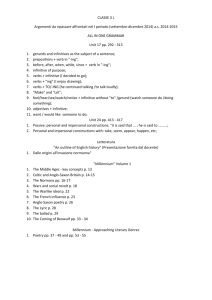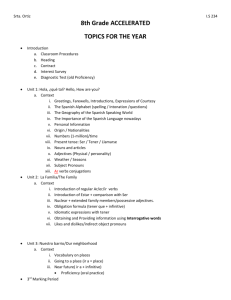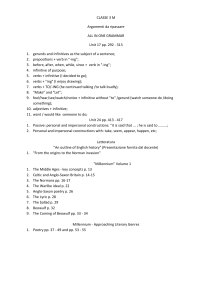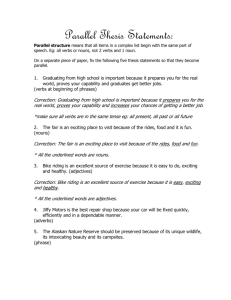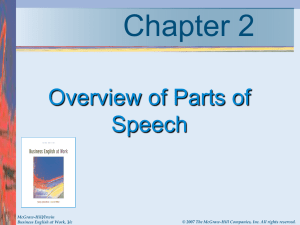Subject content
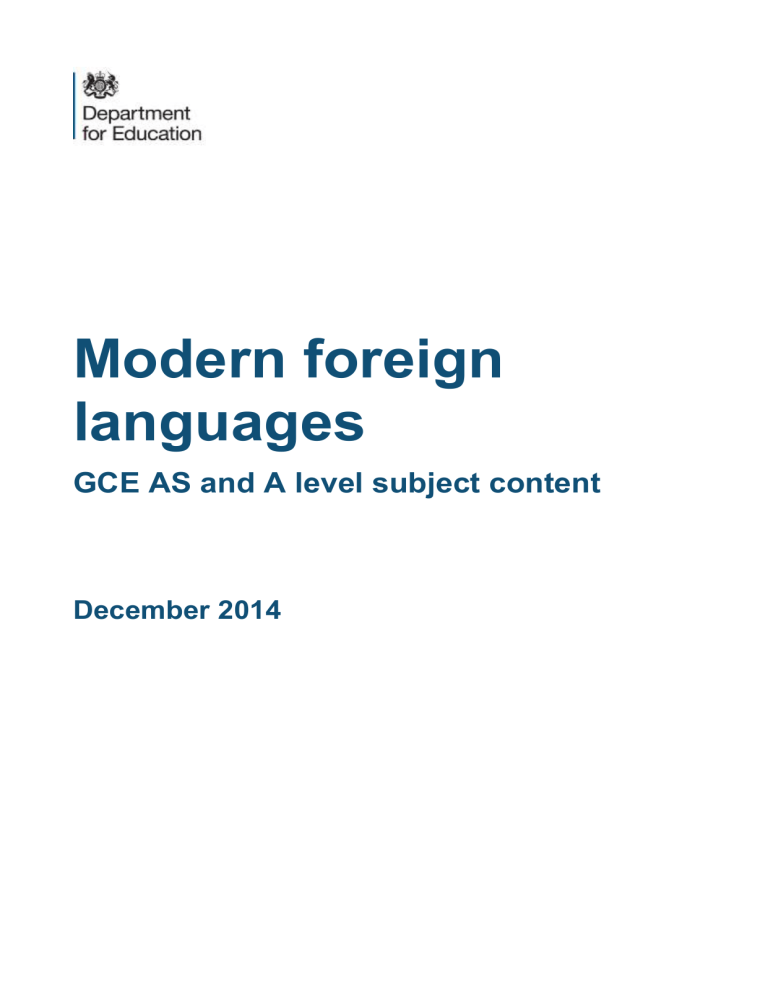
Modern foreign languages
GCE AS and A level subject content
December 2014
Contents
The content for modern foreign languages AS and A level
Annex: grammatical content, appropriate to French, German and Spanish
2
The content for modern foreign languages AS and A level
Introduction
1. AS and A level subject content sets out the knowledge, understanding and skills common to all AS and A level specifications in modern languages.
Context
2. The study of a modern language is understood to be an interdisciplinary subject offering the same cognitive and academic advantages as other disciplines within the humanities. In addition to high level practical language skills, the content of AS and A level in modern foreign languages provides depth of knowledge, understanding and intercultural competence and fosters a range of transferable skills such as communication skills, critical thinking, autonomy, resourcefulness, creativity, and linguistic, cultural and cognitive flexibility; all of which are of value to the individual, to wider society, to higher education and to employers. The content for AS and A level in a modern language has been designed to be of relevance to students of all disciplines, whether they intend to progress to further study in the subject or not. It will provide a robust foundation for those wishing to study a modern language to degree level or equivalent.
Aims and objectives
3. AS and A level specifications in a modern language must enable students to:
enhance their linguistic skills and promote and develop their capacity for critical thinking on the basis of their knowledge and understanding of the language, culture and society of the country or countries where the language is spoken
develop control of the language system to convey meaning, using spoken and written skills, including an extended range of vocabulary, for both practical and intellectual purposes as increasingly confident, accurate and independent users of the language
develop their ability to interact effectively with users of the language in speech and in writing, including through online media
develop language learning skills and strategies, including communication strategies to sustain communication and build fluency and confidence
engage critically with intellectually stimulating texts, films and other materials in the original language, developing an appreciation of sophisticated and creative
3
uses of the language and understanding them within their cultural and social context
develop knowledge about matters central to the society and culture, past and present, of the country or countries where the language is spoken
mediate between cultures and between speakers of the language and speakers of English
foster their ability to learn other languages
equip themselves with transferable skills such as autonomy, resourcefulness, creativity, critical thinking, and linguistic, cultural and cognitive flexibility that will enable them to proceed to further study or to employment
4. In addition, the A level specifications must also enable students to:
develop their capacity for critical and analytical thinking through the language of study
develop as independent researchers through the language of study
Subject content
5. AS and A level specifications in modern languages must build on the knowledge, understanding and skills specified in the GCSE subject content.
6. The content for AS and A level is conceived as an integrated study with a focus on language and culture and society.
7. AS and A level specifications must require students to:
develop knowledge and understanding, through the language of study, of themes relating to the society and culture, past and present, of the country or countries where the language is spoken. Students must study one theme at AS and two themes at A level, from each of the following areas of interest (i.e. 2 themes at AS; 4 themes at A level): i. social issues and trends ii. political and/or intellectual and/or artistic culture
With regard to area of interest (ii):
at AS, students must choose to study one theme from either political or intellectual or artistic culture
at A level, students must study two themes e.g. one theme from political culture and one theme from either intellectual culture or artistic culture, or
4
one theme from intellectual culture and one theme from either political or artistic culture.
at both AS and A level, students must use authentic spoken and written sources from a variety of different contexts and genres, including online media, as stimulus material for the study of the themes and, concurrently, for language development
8. AS and A level specifications must require students to develop their language knowledge, understanding and skills through:
using language spontaneously to initiate communication; ask and answer questions; express thoughts and feelings; present viewpoints; develop arguments; persuade; and analyse and evaluate in speech and writing, including interaction with speakers of the language
applying knowledge of pronunciation, morphology and syntax, vocabulary and idiom to communicate accurately and coherently, using a range of expression – including the list of grammar at annex A for French, German and Spanish, and for other languages, the prescribed list provided in the relevant specification
using language learning skills and strategies, including communication strategies such as adjusting the message, circumlocution, self-correction and repair strategies
listening and responding to spoken passages including some extended passages from a range of different contexts and sources, adapted as necessary, covering different registers and types, including authentic communication involving one or more speakers
reading and responding to a variety of texts including some extended texts written for different purposes and audiences drawn from a range of authentic sources, including contemporary, historical and literary, fiction and non-fiction texts, adapted as necessary
understanding the main points, gist and detail from spoken and written material
inferring meaning from complex spoken and written material, including factual and abstract content
assimilating and using information from spoken and written sources, including material from online media
summarising information from spoken and written sources, reporting key points and subject matter in speech and writing
translating an unseen passage or passages from the language of study into
English at AS and A level
5
translating unseen sentences or short texts at AS, and an unseen passage or passages at A level, from English into the language of study
9. At AS, specifications must also require students to study one work in the language of study, either a literary work or a film. They must:
know, understand and be able to respond critically in writing, in the language of study, to the work, taken from the prescribed list provided in the specification.
10. At AS, knowledge and understanding of the work must include a critical response to aspects such as the structure of the plot, characterisation, and use of imagery or other stylistic features, as appropriate to the work studied.
11. At A level, specifications must require students to study two works, either a literary work and a film, or two literary works, in the language of study. They must:
appreciate, analyse and be able to respond critically in writing, in the language of study, to the works, taken from the prescribed list provided in the specification.
12. At A level, students must develop a more detailed understanding of the works, showing a critical appreciation of the concepts and issues covered, and a critical and analytical response to features such as the form and the technique of presentation, as appropriate to the work studied (e.g. the effect of narrative voice in a prose text or camera work in a film).
13. The works prescribed in the specification must be appropriate authentic sources in the language of study.
the list of literary works must include a range from at least two of the following genres: novels, series of short stories, plays, selections of poems, life writing
(such as autobiography, biography, letters and journals)
the list of films must include feature length films and can include selections of short films organised by theme or director
students are required to study two discrete works at A level i.e. students cannot be assessed on a film adapted from a literary work as well as on the original literary work itself
14. In addition, A level specifications in a modern language must require students to:
develop research skills in the language of study, demonstrating the ability to initiate and conduct individual research on a subject of personal interest, relating to the country or countries where the language is spoken
identify a key question or subject of interest and select relevant information in the language of study from a range of authentic sources, including the internet
6
use information to illustrate knowledge and understanding of the research subject
analyse and summarise research findings, elaborating on key points of interest, as appropriate, through oral presentation and discussion
7
Annex: grammatical content, appropriate to French,
German and Spanish
AS and A level students will be expected to have studied the grammatical system and structures of the language during their course. Knowledge of the grammar and structures specified for GCSE is assumed.
In the examination students will be required to use, actively and accurately, grammar and structures appropriate to the tasks set, drawn from the following lists. The mention of an item in these lists implies knowledge of both its forms and its functions at an appropriate level of accuracy and complexity.
The lists are divided into AS and A level. The examples in italics in parentheses are indicative; that is, they serve to illustrate the part of speech or structure that the candidate must know and hence do not represent an exhaustive specification of the required grammatical knowledge. For items marked (R), receptive knowledge only is required.
French: AS level
Nouns
Gender
Singular and plural forms
Articles
Definite, indefinite and partitive
Adjectives
Agreement
Position
Comparative and superlative
Use of adjectives as nouns (e.g. le vieux, les Anglais )
Demonstrative ( ce, cet, cette, ces )
Indefinite (including autre, chaque, même, quelque )
Possessive ( mon, ma, mes, etc.)
Interrogative and exclamatory (quel, quelle, quels, quelles)
Numerals
Cardinal (e.g. un, deux)
Ordinal (e.g. premier , deuxième )
Expression of time and date
Adverbs
Formation of adverbs in
ment
Comparative and superlative
8
Interrogative (including combien (de), comment, où, pourquoi, quand )
Quantifiers/intensifiers
(including assez, beaucoup, moins, plus, la plupart, plusieurs, presque, tant, très, l trop )
Pronouns
Personal: subject, including on
Object: direct and indirect
Disjunctive/emphatic personal, as subject and object: moi/moi-même , etc.
Position and order
Reflexive
Relative (including qui, que , dont, lequel etc., auquel etc., ce qui, ce que )
Demonstrative ( celui, celle, ceux, celles; and celui-ci/celui-là etc.
)
Indefinite (including quelqu’un, quelque chose )
Possessive ( le mien etc.
)
Interrogative (including qui, que , quoi )
Use of y , en
Verbs
Conjugation of regular er , ir , re verbs, modal verbs, principal irregular verbs, including reflexive verbs
Agreement of verb and subject
Use of il y a
Modes of address ( tu, vous )
Impersonal verbs
Constructions with verbs
Verbs followed by an infinitive (with or without a preposition)
Dependent infinitives ( faire réparer ) (R)
Perfect infinitive
Negative forms
Interrogative forms
Use of tenses
Present
Perfect (including agreement of past participle)
Imperfect
Future
Conditional
Future perfect
Conditional perfect
Pluperfect
Past historic (R)
Use of the infinitive, present participle (e.g. en arrivant ) and past participle
Verbal paraphrases and their uses
(including aller + infinitive, venir de + infinitive)
Passive voice
Present tense
Other tenses (R)
Subjunctive mood: present (common uses, for example, after expressions of possibility, necessity, obligation and after conjunctions such as bien que)
9
Prepositions
All prepositions, both simple (e.g. sous ) and complex (e.g. au-delà de )
Conjunctions
Coordinating conjunctions (e.g. et , ou , mais )
Subordinating conjunctions
Negation
Use of negative particles (e.g. ne...pas, ne...personne, ne...que
)
Use of ne with negative subjects (e.g. Personne n’est venu )
Questions
Commands
Word order
Inversion after speech
Other constructions
Time expressions with depuis and il y a
Comparative constructions
Indirect speech
Discourse markers
(e.g. Au contraire, En fait )
Fillers
(e.g. alors, bon )
French: A level
All grammar and structures listed for AS level, plus:
Verbs
Dependent infinitives ( faire réparer )
Passive voice: all tenses
Subjunctive mood: perfect tense imperfect tense (R)
Word order
Inversion after adverbs
10
German: AS level
Nouns
Gender
Singular and plural forms
Case marking on nouns
Weak masculine nouns
Determiners
Definite article
Indefinite article, including
Demonstratives, including
Possessives kein der/die/das
Other determiners (e.g. alle , viel/viele, welcher )
Pronouns
Personal pronouns
Reflexive pronouns
Relative pronouns
Demonstrative pronouns
Possessive pronouns
Indefinite pronouns (e.g. jemand )
Interrogative pronouns (e.g. wer )
Adjectives
Adjectival endings
Comparative and superlative
Adjectives with the dative (e.g. es ist mir klar
Adjectives with prepositions (e.g. stolz auf )
)
Adverbs and adverbials
Time
Place
Direction (e.g. hin , heraus )
Manner
Degree (e.g. sehr )
Interrogative ( e.g. wann, warum)
Comparative and superlative
Numbers and fractions
Clock time, days of the week, months
Modal Particles / Discourse Markers e.g. ja , doch , wohl
Verbs
Principal parts of weak, strong and irregular verbs
Reflexive verbs
Separable/inseparable
Auxiliary verbs ( haben, sein, werden )
11
Use of haben or sein in the perfect
Modal verbs ( dürfen, können, mögen, müssen, sollen, wollen ): present and imperfect tenses; imperfect subjunctive of mögen and können
Infinitive constructions ( um… zu , ohne… zu , verbs with zu )
Infinitive constructions ( lassen and sich lassen with infinitive)
Tense, voice and mood
Present
Past (i.e. simple past/imperfect)
Perfect
Perfect (modal verbs) (R)
Pluperfect
Future
Future perfect (R)
Conditional
Conditional perfect (R)
Passive with
Imperative werden
Subjunctive in conditional clauses (past)
Subjunctive in conditional clauses (pluperfect) (R)
Subjunctive in indirect speech (R)
Prepositions
Fixed case and dual case
Prepositional adverbs ( da ( r )+preposition, e.g. darauf )
Conjunctions
Coordinating
Subordinating
The case system
The subject and the finite verb
Accusative objects
Dative objects
Prepositional objects
The use of the nominative case with copular verbs (e.g. sein, werden , bleiben )
Clause structure and word order
Main clause word order
Questions and commands
Position of pronouns
Position of adverbials
Position of nicht
Word order variation to change emphasis
Subordinate clauses introduced by a conjunction (e.g. dass , obwohl )
Word formation
Compound nouns
Forming nouns from verbs
12
Forming nouns from adjectives
Forming verbs from nouns
Forming verbs from adjectives
Separable and inseparable verb prefixes
German: A level
All grammar and structures listed for AS level, plus:
Adjectives
Use of long adjective phrases (R)
Tense, voice and mood
Perfect (modal verbs)
Future perfect
Conditional perfect
Conditional sentence with omitted wenn , e.g. Hätte ich mehr Zeit gehabt, wäre das nicht passiert (R)
Passive with sein
Subjunctive in conditional clauses (pluperfect)
All forms of indirect speech
Clause structure and word order
Use of the prepositional adverb ( da ( r )+preposition, e.g. darauf ) to anticipate dass clauses and dependent infinitive clauses (R)
Spanish: AS level
Nouns
Gender
Singular and plural forms
Plural of male/female pairs (e.g. los Reyes )
Affective suffixes (R)
Articles
Definite and indefinite
El with feminine nouns beginning with stressed a ( el agua )
Lo + adjective
Adjectives
Agreement
Position
Apocopation (e.g. gran , buen , mal, primer )
Comparative and superlative (e.g. más fuerte ; mejor, peor, mayor, menor )
Use of adjectives as nouns (e.g. una triste, la roja, las norteamericanas )
Demonstrative (e.g. este, ese, aquel )
Indefinite (e.g. alguno, cualquiera, otro )
13
Possessive (weak and strong forms) (e.g. mi / mío )
Interrogative and exclamatory (e.g. ¿cuánto? / ¡cuánto!
, etc., including use of ¿qué?
/ ¡qué!
)
Relative ( cuyo ) (R)
Numerals
Cardinal (e.g. uno, dos )
Ordinal 1-10 (e.g. primero, segundo )
Agreement (e.g. cuatrocientas chicas )
Expression of time and date
Adverbs
Formation of adverbs in
mente
Comparative and superlative (e.g. más despacio )
Use of adjectives as adverbs (e.g. rápido, claro )
Adjectives as equivalents of English adverbs (e.g. Salió contenta )
Interrogative (e.g. ¿cómo?, ¿cuándo?, ¿dónde?
)
Quantifiers/intensifiers
(e.g. muy, bastante, poco, mucho )
Pronouns
Subject
Object: direct and indirect; use of se for le(s) ; ‘redundant’ use of indirect object (e.g.
Dale un beso a tu papá )
Reflexive
Unstressed / stressed forms (e.g. me / mí )
Position and order
Relative ( que, quien, el que, el cual )
Demonstrative ( este, ese, aquel ; esto, eso, aquello )
Indefinite (e.g. algo, alguien )
Possessive (e.g. e l mío, la mía ). Expression of possession by the use of the indirect object pronoun ( Le rompió el brazo ) must also be included.
Interrogative
Verbs
Regular conjugations of ar, -er and ir verbs, including radical-changing (e.g. recordar / recuerdo , pedir / pido ) and orthographic-changing (e.g. abrazar / abracé ) verbs, in all tenses and moods, finite and non-finite forms
Regular and Irregular verbs, in all tenses and moods, finite and non-finite forms
Agreement of verb and subject
Use of hay que in all tenses
Use of tenses
Present
Preterite
Imperfect
Future
Conditional
Perfect
Future perfect
14
Conditional perfect
Pluperfect
Use of the infinitive, the gerund and the past participle
Verbal paraphrases and their uses. These include but are not limited to the following: ir a + gerund estar + gerund acabar de + infinitive estar para + infinitive llevar + gerund ir + gerund (R) venir + gerund (R)
Use of the subjunctive
Commands
Conditional sentences
After conjunctions of time
After para que, sin que
In relative clauses (R)
After other subordinating conjunctions (R)
With verbs and verbal expressions of wishing, commanding, influencing, emotional reaction, doubt, denial, possibility, probability (R)
Sequence of tense in indirect speech and other subordinate clauses
Voice
Use of the reflexive as a passive (e.g. El puente se construyó para unir a las comunidades )
Use of the reflexive to express an impersonal subject (e.g. ¿Cómo se llega a la estación?
)
Use of ser + past participle
Use of estar + past participle
‘Nuance’ reflexive verbs (e.g. caerse, pararse )
Modes of address ( tú, usted ; vos (R))
Constructions with verbs
Verbs followed directly by an infinitive (e.g. querer, poder )
Verbs followed by a preposition plus an inifnitive or noun phrase (e.g. insistir en , negarse a )
Verbs followed by a gerund (e.g. seguir )
Verbs of perception (e.g.
Uses of ser and estar
Vi asfaltar la calle )
Prepositions
All prepositions, both simple (e.g. bajo ) and complex (e.g. encima de )
‘Personal’ a
Discrimination of por and para
Conjunctions
Coordinating conjunctions (e.g. y, o, pero )
Subordinating conjunctions. These include but are not limited to the following:
Cause ( porque )
Purpose ( para que )
Proviso ( con tal que )
Supposition ( a no ser que )
15
Negation
Questions
Time ( cuando )
Concession ( aunque )
Use of que to introduce a clause (e.g. ¡Cuidado, que se va a quemar la tortilla!
) (R)
Commands
Word order
Subject following verb ( Ha llegado el profesor; Me gustan las patatas )
Focalisation ( Tú ¿qué opinas?; A Cristiano lo odian ) (R)
Other constructions
Time expressions with hace / hacía and desde hace / hacía
Cleft sentences ( Fue en Madrid donde nos conocimos )
Comparative constructions. These include but are not limited to the following: tan... como...
, etc. más... que...
, etc.
Tiene más dinero de lo que creía (R)
Indirect speech
Discourse markers
(e.g. Es que..., Por ejemplo, Ahora bien...
)
Fillers
(e.g. pues , bueno )
Spanish: A level
All grammar and structures listed for AS level, plus:
Adjectives
Relative ( cuyo )
Verbs
Use of the subjunctive
In relative clauses
After other subordinating conjunctions
With verbs and verbal expressions of wishing, commanding, influencing, emotional reaction, doubt, denial, possibility, probability
Conjunctions
Use of que to introduce a clause ( ¡Cuidado, que se va a quemar la tortilla!
)
Other constructions
Comparative constructions
16
Tiene más dinero de lo que creía
Expression of concession other than by aunque ( por muy adjective que, por mucho que ) (R)
17
© Crown copyright 2014
You may re-use this document/publication (not including logos) free of charge in any format or medium, under the terms of the Open Government Licence v3.0. Where we have identified any third party copyright information you will need to obtain permission from the copyright holders concerned.
To view this licence: visit www.nationalarchives.gov.uk/doc/open-government-licence/version/3 email psi@nationalarchives.gsi.gov.uk
About this publication: enquiries www.education.gov.uk/contactus download www.gov.uk/government/publications
Reference: DFE-00694-2014
Follow us on Twitter:
@educationgovuk
Like us on Facebook: facebook.com/educationgovuk
18



